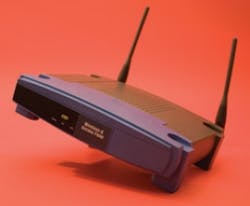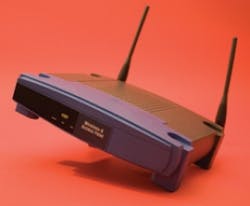More bandwidth will enable video on smartphones
From the December, 2011 Issue of Cabling Installation & Maintenance Magazine
The 5-GHz band provides significant opportunity, if people will just use it.
By Scott D. Thompson, Oberon Inc.
Have you ever had trouble connecting or completing a mobile phone call? (Am I trying to be funny?!) Despite the billions of dollars invested in cellular infrastructure, there are still apparent voids in coverage. Are these actually voids in signal coverage, or is there another problem with the connection? In some cases, what appears to be a void in signal coverage is actually a void in capacity. As more mobile devices attempt to connect to a given cellular base station, the collective interference raises the noise floor in which that base station is operating. This has the same effect of “reducing coverage.” So a location that may seem to have good service during off-peak periods may not have good service during peak periods. At the extreme, if enough mobile devices are trying to connect to the base station, the radio access network cannot accept additional requests for service so the call is blocked entirely. And of course, with the proliferation of smartphones, this problem will only get worse.
The Federal Communications Commission (FCC) predicts a critical shortage in useable spectrum for cellular systems, particularly in urban areas, by mid-2012. The attempt of AT&T to acquire T-Mobile is entirely to satisfy AT&T’s need to aggregate more spectrum for 3G and 4G services, and T-Mobile’s recognition that it does not have enough spectrum to compete. Currently the combination of cellular and PCS spectrum provides only 170 MHz of widely available public spectrum, although the FCC is working on freeing up an additional 377 MHz of spectrum, for a total of 547 MHz of public spectrum. This will take years, if not decades, for the carriers to deploy.
Smartphones using WiFi
Forward-looking product designers recognize this shortage, resulting in the integration of WiFi chipsets into virtually all tablet and smartphone devices. The anticipation, and reality within many buildings, is that WiFi will be as ubiquitous as cellular coverage for mobile networking. Thus Apple’s recent announcement that the iPhone 4S will support text messaging over WiFi (iMessage), so that the wireless LAN can augment, or offload, traffic from the congested public cellular network. Although text messaging is a relatively low-bandwidth use of spectrum, Apple’s FaceTime, which is essentially mobile video calling, uses much greater bandwidth, and thus is restricted to the WiFi network. Motorola’s Android Bionic supports video chat over WiFi.
As I have discussed previously (see “WiFi offloading, cell-phone batteries and dual-band access,” September 2011), WiFi or wireless LAN offers a means to offload some of the wireless Internet (and voice) traffic from the cellular network to a local premises or public LAN. WiFi offers 480 MHz of much-needed spectrum at 2.4 GHz and 5 GHz, which can be deployed relatively quickly in private and public spaces. Most of this spectrum (420 MHz) is between 5 and 6 GHz, with about 80 MHz available in the 2.4-GHz band. Fortunately, most of the commercial wireless routers and WiFi access points are dual-band, meaning they operate in both the 2.4- and 5-GHz bands simultaneously. And many mobile client devices are dual-band also, including most laptops and tablets, such as the Apple iPad and the Cisco Cius. Unfortunately, even though there is about 7 times more bandwidth available in the 5-GHz versus the 2.4-GHz space, most clients operate in the 2.4-GHz band. This is because 2.4 GHz is a default setting in many mobile clients. Smartphones generally operate in the 2.4-GHz band only due to hardware constraints, further contributing to this congestion. This scenario, however, is changing.
2.4-GHz by default
An informal survey of college campuses I monitored reveals that only about 20 to 25 percent of wireless LAN devices are connecting through the 5-GHz band despite the 5-GHz band’s 7x bandwidth offering. This appears to be largely driven by the fact that smartphones are 2.4-GHz-band-only. In one scenario, when a course syllabus requested that students bring laptops, and leave their phones turned off, the 5-GHz connection ratio jumped to more than 40 percent. Thus, the density of 2.4-GHz users appears to be largely driven by the fact that smartphones have been restricted to the 2.4-GHz band only.
If so much more spectrum is available at 5 GHz, and laptops and tablets are already using dual-band chipsets, why are few smartphones dual-band? Smartphone batteries are, of course, much smaller than laptop batteries. So phone designers are very sensitive to the power drawn by radio-frequency chips. Presumably, a dual-band WiFi chipset is going to draw more power than a single-band chip, adversely impacting talk-time. But this differential is becoming less consequential. A new generation of dual-band chipsets, designed specifically for smartphones, is emerging. These chips engage the same highly effective power-miserly techniques that the phones use in the cellular band, including shutting off the transmit power amplifier stage when not transmitting. As the impact on battery charge is mitigated, and the advantage of selling “dual-band WiFi” smartphones emerges, more users will migrate to the relatively underutilized 5-GHz spectrum.
Changes in the air
Many wireless LAN operators have planned diligently for 5-GHz operation, including investing in densely packed dual-band access points and antennas to provide for high capacity—only to be disappointed in the paucity of 5-GHz-band users. What is an administrator to do? How does one encourage more users to homestead on the open range of 5 GHz? Many wireless LAN vendors offer “band-steering” capabilities in their products that communicate with the client device about capabilities, and they steer the client device to the best available band. Another step is to disable 802.11b functionality in the access point. 802.11b is 2.4-GHz-only, so by disabling it, some clients may then move to 5 GHz. 802.11b slows down 802.11g devices at 2.4 GHz also, so disabling 802.11b is doubly advantageous.
Another method is to name the 5-GHz band SSID something like “Fast Internet” or “High-speed WiFi” to encourage users to select that band. Some dedicated laptops, tablets and PCs can be configured to operate in the 5-GHz band only. Certainly as wireless-network users seek better connections for video and image downloads and video chat, they will be actively seeking more open range of spectrum. Engaging the 5-GHz band more fully will mitigate cellular and 2.4-GHz WiFi congestion, help to satisfy user bandwidth demands, and reduce data and text charges for users—and leave more of the cellular spectrum available for outdoor mobile use.
Scott D. Thompson is president of Oberon Inc. (www.oberonwireless.com).

